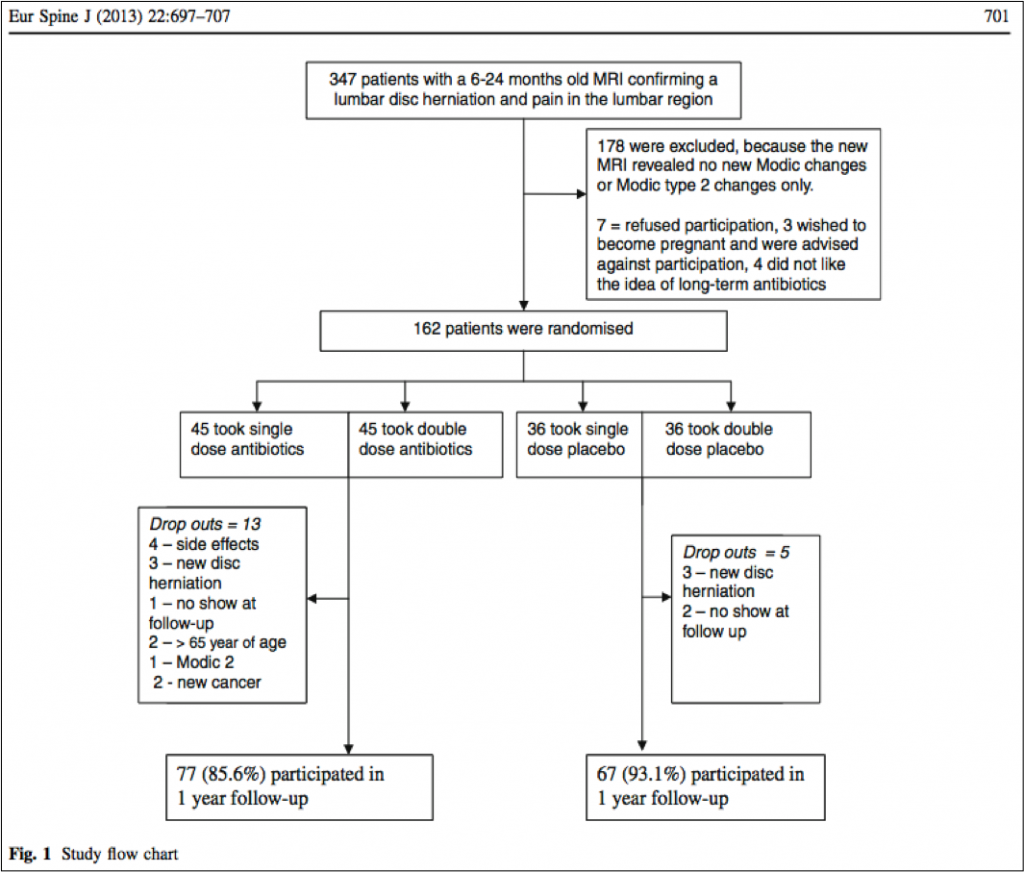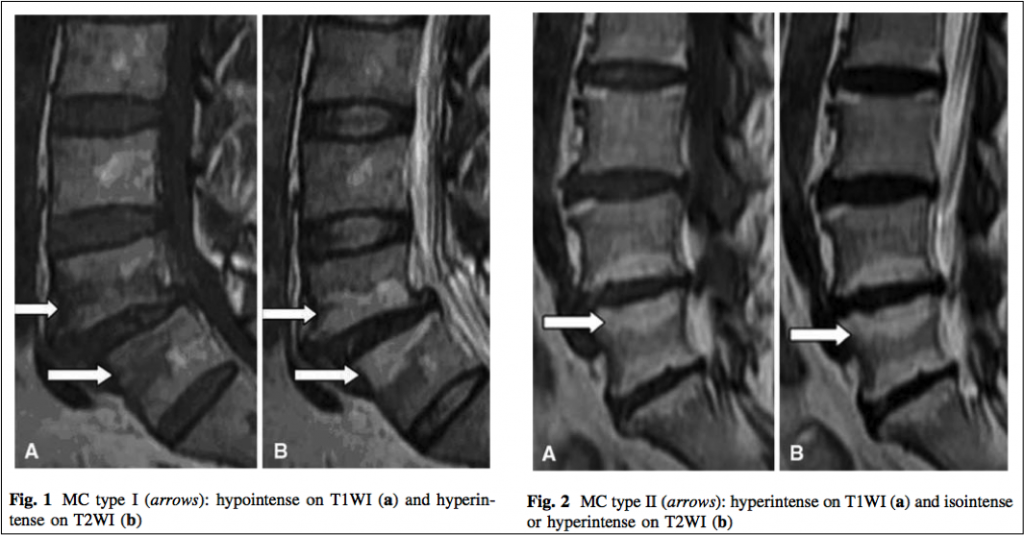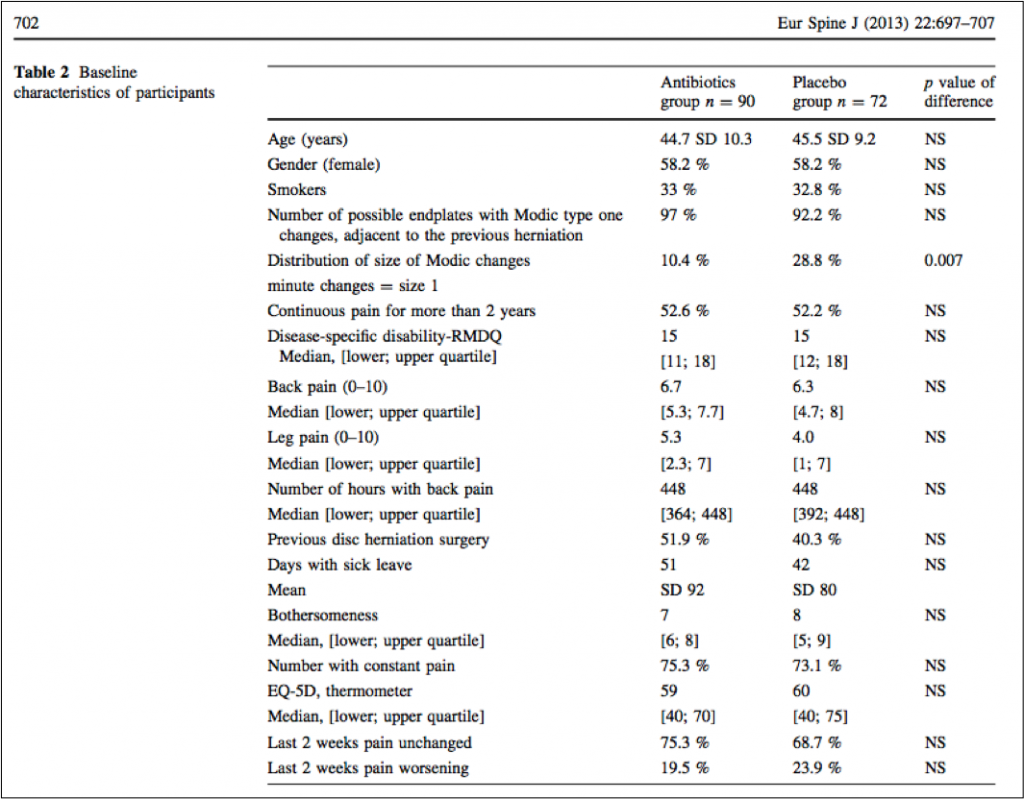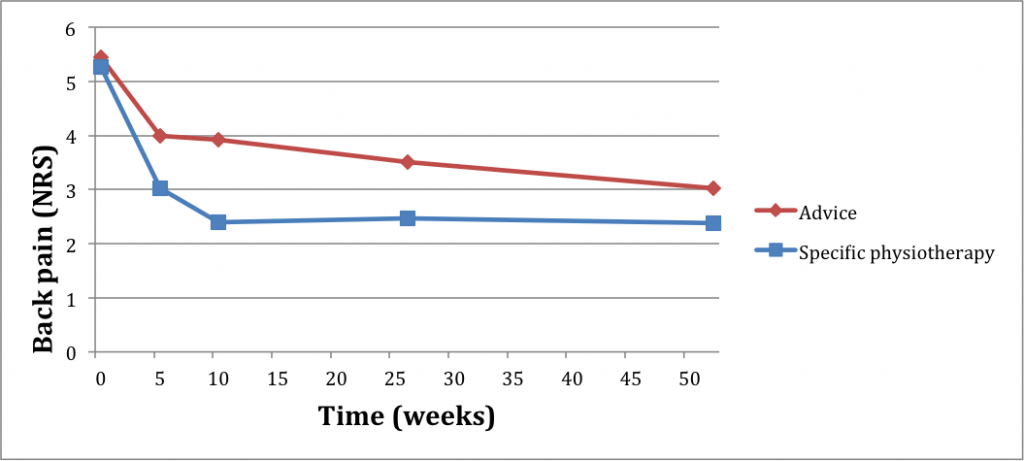Hello to all and welcome to my blog courtesy of stopsbackpain.com.au.
Today we’re going to have a closer look at Hanne Albert’s paper. In February 2013 Albert published a paper titled “Antibiotic treatment in patients with chronic low back pain and vertebral bone edema (Modic type 1 changes): a double-blind randomized clinical controlled trial of efficacy” in the European Spine Journal.
The following figure shows that to be included in the study you had to have MRI evidence of lumbar disc herniation as well as Modic type 1 changes at the same segmental level. You can also see that patients were randomised to take low dose, high dose or placebo antibiotics.
From Albert et al 20131
Modic changes are diagnosed by T1 and T2 weighted MRI scans (see figure below). Type I changes (hypointense signal in T1 weighted imaging and hyperintense signal in T2 weighted imaging) have been shown to correspond to vertebral body oedema and hypervascularity. Modic type II changes (hyperintense signal in T1 and hyperintense signal in T2 weighted images) reflect fatty replacements of the red bone marrow2.
From Zhang et al 2008
In the following table you can see that the patients were similar between the antibiotics and placebo groups at baseline. Notably half of the patients recruited had had previous surgery for disc herniation. On average the patients had moderate to marked severity persistent back and leg pain.
From Albert et al 2013
The results of the study were impressive. Large and clinically important differences between the antibiotic and placebo groups were noted for activity limitation, back pain, and leg pain as summarised in the following table.
There is some evidence to support the authors’ proposition that an infection of the disc and vertebral endplate/bone marrow by proprionibacterium acnes bacteria (the same bug that causes acne) is the cause of these patients’ back and leg pain. Treatment by a 100 day course of amoxicillin–clavulanate (Bioclavid) antibiotic appears to improve outcomes based on these data.
The paper concluded with the statement:
“Antibiotics could be considered as a treatment option for this special subgroup of patients with CLBP and Modic type 1 changes after a lumbar disc herniation when all other treatment options have failed. More confirmatory work in other populations and studies on improved protocols as well as the background science should be encouraged.”
The reaction…
There are some enthusiastic quotes available in the mainstream media regarding the effects of antibiotics on back pain as a result of the Albert et al study.
“This is vast. We are talking about probably half of all spinal surgery for back pain being replaced by taking antibiotics,” said Peter Hamlyn as quoted in The Guardian
“The stuff of Nobel prizes.” From Peter Hamlyn as quoted in The Mail Online
A number of commentators have criticised the PR campaign associated with the paper here and here.
One of the primary concerns has been a conflict-of-interest. Around the time of publication of Albert et al, a website promoting the treatment of low back pain with antibiotics (MAST) was launched. It is of interest that three of the MAST directors are authors on the Albert paper. The other director is the oft quoted Peter Hamlyn.
A number of commentary pieces have also been published in the European Spine Journal3-6. Apart from the conflict of interest issue, other concerns have been raised including:
- The lack of response in the placebo group to the treatment which is atypical in most placebo controlled trials
- The fact that 50% of the patients in the trial had already had lumbar discectomy surgery
- The potential adverse public health effects of 100 day antibiotic treatment program in terms of development of bacterial resistance
- And finally a considered editorial response from the European Spine Journal. In this paper the evidence was presented supporting the potential mechanisms for proprionibacterium acnes in the development of low back pain and the significance of Modic changes. The language of “cure for low back pain” was disputed given the data showing clearly that many patients remained in significant back pain even after the treatment had been successfully provided. Further research and replication of the Albert trial was recommended. However consideration of antibiotics for low back and leg pain was supported provided the patients are carefully selected and:
- Had low back pain of more than 6 months duration not responsive to exercise therapy
- Had a symptomatic disc herniation within the previous year
- Had Modic type 1 changes at the same level as the disc herniation
The response…
The response to the criticisms by Albert et al in the European Spine Journal is revealing. After reading the criticisms of this clinical trial, one is tempted to dismiss the findings. However Albert’s justifications are reassuring and include:
- An assertion that the natural history of high severity persistent low back pain patients is poor and that therefore the placebo response should be expected
- An acknowledgement that the treatment is only appropriate for carefully selected low back pain patients
- The assertion that 100 days is a reasonable period of treatment with antibiotics to ensure that partial treatment and resultant bacterial resistance does not occur
- An explanation that the MAST website was only set up after data collection had been complete and that therefore a conflict-of-interest was not evident
- And finally an agreement with the editors of the European Spine Journal that treatment with antibiotics must be only considered for highly specific patient populations and that further research and replication of the trial is required
In comparison
It is of interest that our own clinical trial on persistent and recurrent low back pain shows similar effects to that published by Albert et al. As the following figure shows, specific physiotherapy resulted in a reduction of back pain of approximately three points in a moderate to severely affected sample. The key difference in the Specific Treatment of Problems of the Spine (STOPS) trial was that the comparison group was guideline-based advice that also had a significantly positive effect. Nevertheless we found clinically important differences between the groups. These data will be published shortly and we can only hope that the paper is so well received by the main stream media!
Ford et al 2013
The study from Albert et al is comparable with our own results in the STOPS trial. That is, some patients respond extremely well to specific treatment and that others require a different approach. Identification of patients that are likely to be responders remains an inexact science. This means from a clinical perspective that detailed assessment and analysis of patient presentations with the application of specific treatment is an ongoing requirement. There is no silver bullet!
The wash up…
Our reading of the Albert paper is that antibiotics may well be highly effective in a specific subgroup of back pain. Certainly following the scientific and mainstream media has also been an interesting exercise.
If you’re interested in a free eLearning module on this and other topical issues click here, subscribe and follow the links.
I’d love to have a dialogue with the Physiopedia audience so feel free to comment below.
Until next time.
Jon Ford
STOPS back pain as part of Knowledge and Learning Solutions International is declared an educational institution under s.10 of the Copyright Act 1968. This notice is published in accordance with s.10A(4) of The Act.




